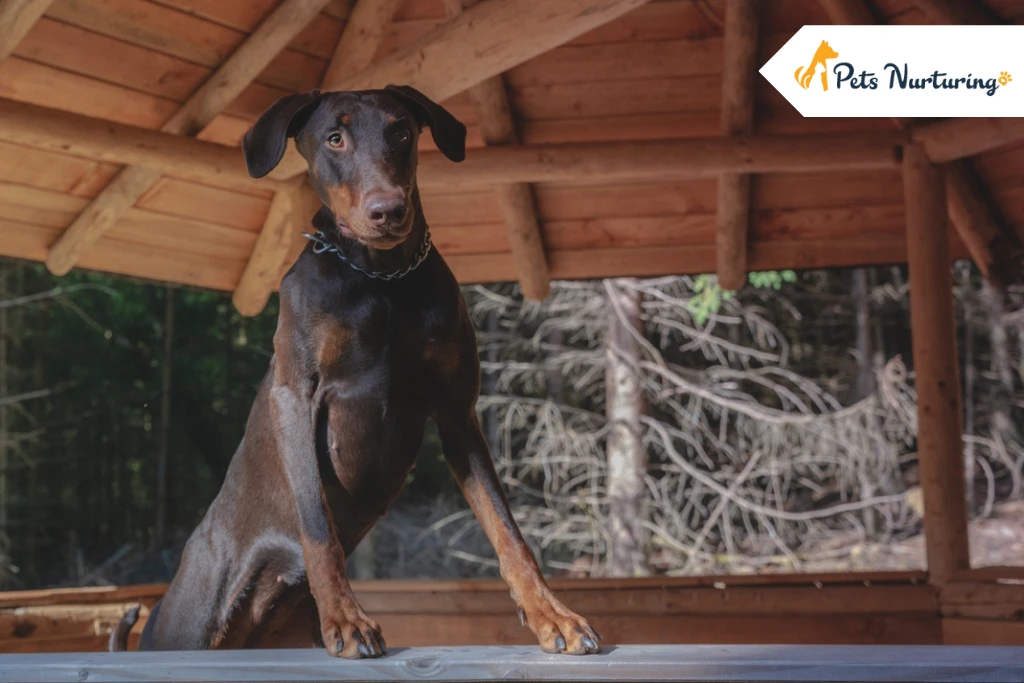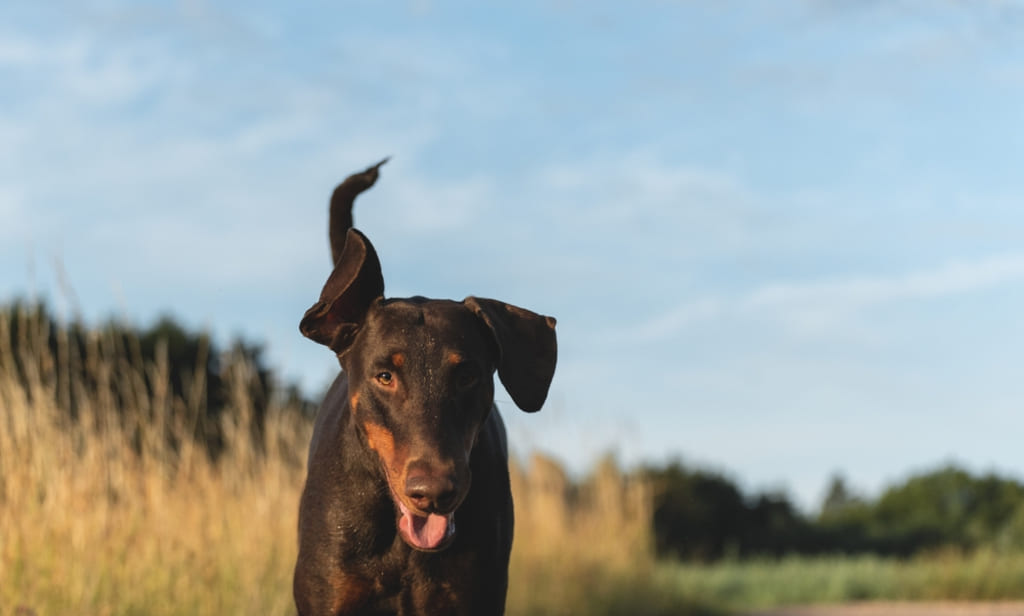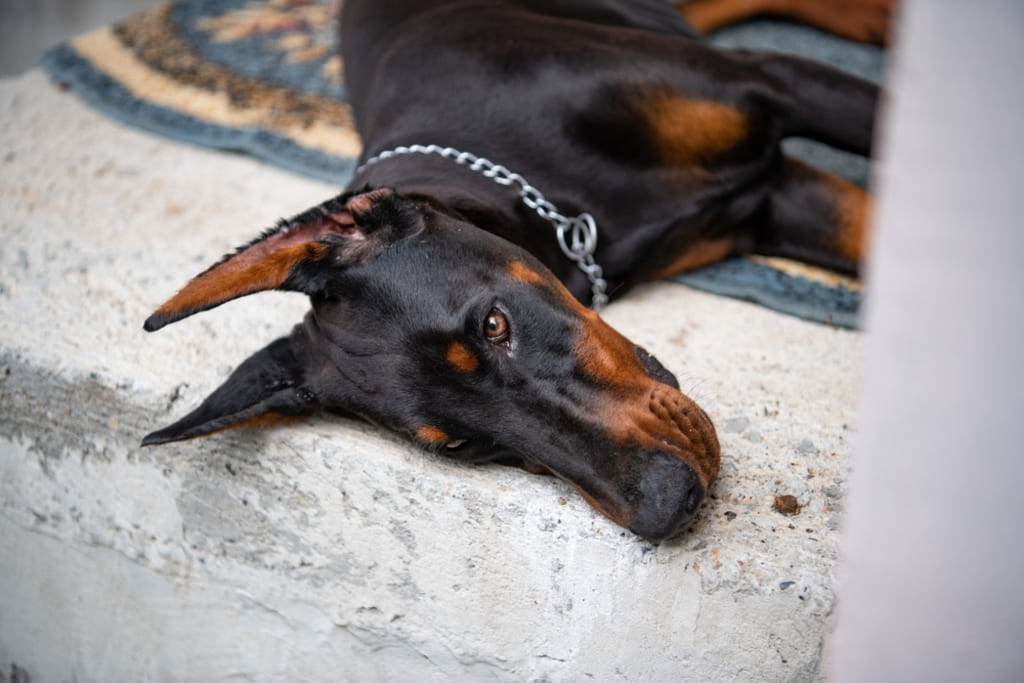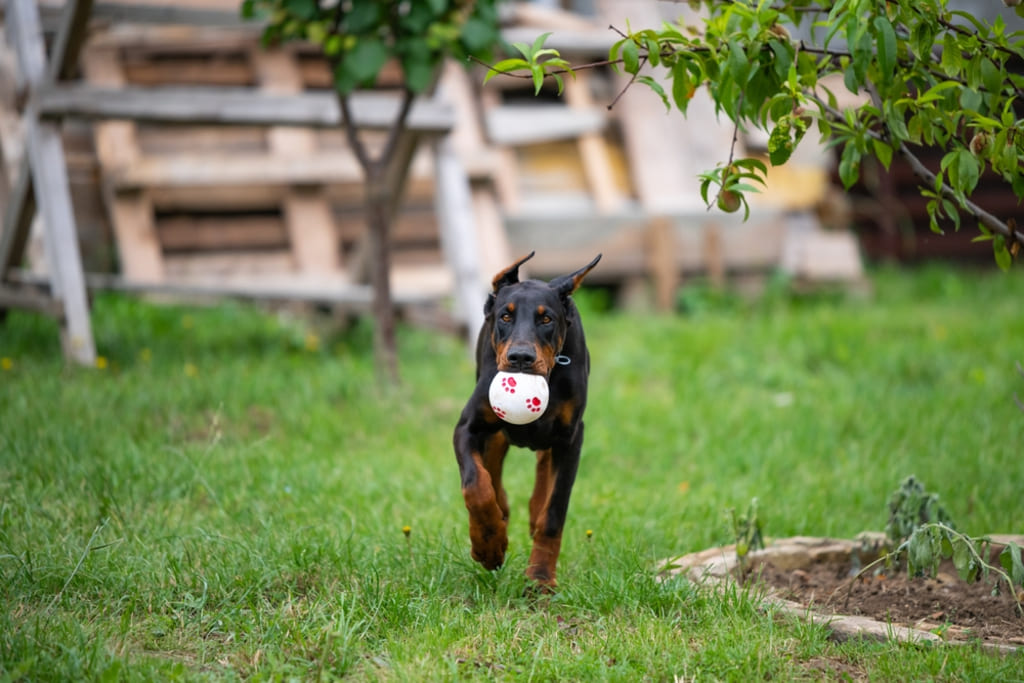
If you are looking for an active and loyal dog that can protect you, European Doberman is an excellent choice. Contrary to their dominant personality, these dogs are very affectionate and love to cuddle. The best thing about the breed is that they are extremely smart, ranking number 5th in terms of intelligence. This makes them very easy to train. However, they have high exercise requirements and need good mental stimulation to stay healthy.
If you plan to get a European Doberman, this guide will offer you all the information. We are going to discuss the breed’s origin, characteristics, diet requirements, exercise, and grooming needs.
European Doberman Breed Overview
Breed Group: Working
Height: 25 to 28 inches
Weight: 64 to 106 pounds
Lifespan: 10 to 12 years
Coat: Short and smooth
Color: Black or brown with rust red
Temperament: Intelligent, loyal, protective and fearless
Needs for Grooming: Low to moderate
Hypoallergenic: No
Origin: Germany
History

European Doberman was first produced in the 1880s by a man named Karl Friedrich Louis Dobermann. He worked as a tax collector and managed a dog pound in Apolda, Germany. Dobermans are named after him and are also known as “Tax Collector’s Dog”.
Karl wanted a dog to protect him, and with access to dogs of different breeds, he came up with the idea of creating a new kind of dog – one that would be strong, intelligent, and have impressive stamina.
The Doberman is thought to have been developed from several dog breeds with the traits Karl sought. While the exact mixing ratios and breeds used are uncertain, many professionals believe it’s a combination of breeds like
- German Pinscher
- Beauceron
- Rottweiler
- Weimaraner
- Greyhound
- Manchester Terrier
- German Shepherd
After Karl’s demise in 1894, the Germans called the dog Dobermann-pinscher as his tribute. However, the term pinscher was dropped by Germany and Britain.
Five years after Dobermann passed away, Otto Goeller perfected the dog breed and formed the National Doberman Pinscher Club in the 1890s. European Dobermans make great working dogs because they must pass a test called the ZTP before they are allowed to breed.
Dobermans are the fifth most intelligent dogs in the world.
Appearance
European Dobermans are medium-sized dogs with slender bodies and athletic build. They have a thicker bone structure with a compact yet broader physique.
Their head is broad with a long muzzle and muscular jaw. The best feature about Dobermans is their oval-shaped and dark-colored eyes. It gives them an intense and alert look.
These dogs have a short and thick neck with a broad chest. Also, their legs are straight and stockier to help them run faster. European Dobermans tend to be 10% bigger than their American counterparts as they are specifically bred to be work dogs.
As per the FCI standards, here’s the ideal European Doberman size.
| Gender | Height | Weight |
|---|---|---|
| Male | 27 to 28 inches | 79 to 106 lbs |
| Female | 25 to 27 inches | 64 to 86 lbs |
Coat and Color

The European Doberman has a short, dense, and hard coat that feels soft to the touch. They come in two colors of coat – black and brown with rust red. This is because the FCI doesn’t recognize any undercoat on the body.
Doberman European breeders are required to produce these two specified shades as they align with the breed’s overall characteristics. Despite this rule, some breeders also produce blue, red, and fawn European Dobermans.
Various coat colors of the European Doberman include,
- Black and tan
- Blue and tan
- Red and tan
- Fawn and tan
For markings, the FCI only accepts the tan color. These tan markings are typically found on different parts of the dog’s body. You can find the marks on their muzzle, forechest, throat, and above the eyebrow. Their hind thigh inner side, feet, forearms, and the area under the tail may also have markings.
Characteristics and Temperament
European Dobermans are known for their assertiveness. This makes them the top choice for police work and similar tasks. However, they are also very affectionate and devoted to their owner and family.
While they can be laid-back, they are not fans of sharing their space with other pets. Their protectiveness can sometimes lead to physical confrontations with others.
They don’t back down when their family is in danger and will bark or bite without hesitation. European Dobermans thrive with strong discipline, so make sure you train them. You can build their confidence through discipline, training, and leadership tasks.
One thing about these dogs is that they are attuned to human emotions, especially those of their owner. They will know when you are sad and will stay by your side.
Dobermans are not afraid of new environments and can be outgoing and lively. They have a strong prey drive, so going collar-free is not recommended. Without proper training, they may jump on strangers.
European breeders seek confident Dobermans with a strong work ethic. They excel in working events and are born for police and military work.
If you are looking for a dog proficient in personal and property protection, European Dobermans are a suitable choice. These dogs can quickly adapt to their role as guard dogs and will offer you protection.
Here are some qualities of a European Doberman:
- Devoted, brave, and watchful
- Affectionate and committed to their family
- Exceptional in police and military tasks
- Highly protective
- Aggressive
- Sensitive to human emotions
- Displays a strong instinct for chasing prey
- Courageous when encountering strangers
- Thrives on strong discipline
Dobermans love to work and enjoy performing tasks.
Health and Nutrition

European Dobermans need a highly nutritious diet as they are active dogs. You need to give them food that contains multivitamins, minerals, and proteins in the right amount.
An adult dog will need around 4 to 7 cups of food per day. You can divide it into two equal meals and feed them in the morning and evening. Puppies will need 3 to 4 meals a day, depending on their age and weight.
Consult a vet to choose the right type of food for your Doberman. They will provide you with proper feeding guidelines. Apart from food, you also need to give them a fresh supply of water.
Common Health Problems
European Doberman is generally considered a healthy dog, given their active lifestyle. However, they are still prone to some genetic health problems. Here are some common health problems in European Dobermans:
- Osteosarcoma
- Bloating
- Dilated cardiomyopathy
- Hip dysplasia
- Chronic Active Hepatitis (CAH)
- Hypothyroidism
- Progressive Retinal Atrophy (PRA)
- Cervical vertebral instability
- Von Willebrand’s disease
Regular veterinary checkups are essential to address these concerns. Apart from health checkups, you also need to get European Doberman puppies from a reputable breeder.
Behavior and Training
Due to their size and assertive temperament, European Dobermans may not be considered ideal as family pets. Nevertheless, European Dobermans can still become well-behaved family pets with professional training and early socialization.
A properly instructed and socialized European Doberman is an excellent addition to your house and can be safe around little kids. It’s crucial to socialize with your dog as they can be skeptical towards strangers. They are very intelligent and love pleasing their owner, which makes them easy to train.
You can start training your dog from an early age. They can be aggressive and have a strong prey drive, so training is essential. You can use positive reinforcements like praises and rewards as motivation. Remember not to use harsh training methods, as they can lead to destructive behaviors.
Exercise Needs

European Dobermans are recognized for being agile and lively. To prevent any destructive behavior and ease your Doberman’s anxiety, make sure to give them 1 to 2 hours of exercise each day.
You can take your Doberman outdoors for activities such as chasing treats in a safe and enclosed park. They love to go on walks and runs with you. However, remember to keep them on a leash, as they can run after cats and squirrels.
Apart from physical exercise, you must also provide mental stimulation to your dog. They are intelligent and can quickly get bored if they have nothing to do. You can use interactive games or assign them tasks to keep them busy.
Dobermans are actually born with floppy ears and tail, which is later docked
Grooming Needs
European Dobermans carry a thick and short coat that sheds moderately throughout the year. Since they are typically clean dogs, they don’t need much grooming.
As part of grooming, make sure to clear boogers and dirt near their eyes. You also need to brush your teeth at least one time a day. To minimize shedding, comb their coat a minimum of once a week.
You also need to trim their nails and clean their ears from time to time. Apart from this, use proper shampoo to give them a bath. You can groom them on your own or take them to a professional groomer.
Are European Doberman Hypoallergenic?
Dobermans are not hypoallergenic dogs. If you’re prone to dog allergies, having a Doberman may worsen your symptoms. However, you can prevent shedding with regular baths, consistent hair brushing, and maintaining good hygiene.
Price
European Dobermans tend to be pricier and can cost around $2,500 to $3,500 if you buy from reputed breeders. However, you can also find European Doberman for sale between $500 and $2,000.
Keep in mind that you check the health certificates of the dog before purchasing them. It will help you to get a healthy dog without any genetic health issues.
Lifespan
On average, European Dobermans live for 10 to 12 years. However, since they can be susceptible to certain genetic disorders, taking your furry friend to the vet for checkups regularly is crucial.
FAQs
European Doberman is slightly bigger and more aggressive than its American counterpart.
Although they are mainly used as working dogs in the police force, they can be decent family dogs with proper training and socialization.
Yes, European Dobermans are stronger because of their taller stature and muscular body.
Conclusion
There you have it – all the information about European Doberman! By reading our guide, you can easily decide if the dog is suitable for you. It will also give you all the details about how to care for them, including their diet, exercise, and grooming requirements. Now that you know how wonderful these dogs are don’t wait anymore. Find a reputable breeder and bring your ideal furry companion home.
Explore Further:











